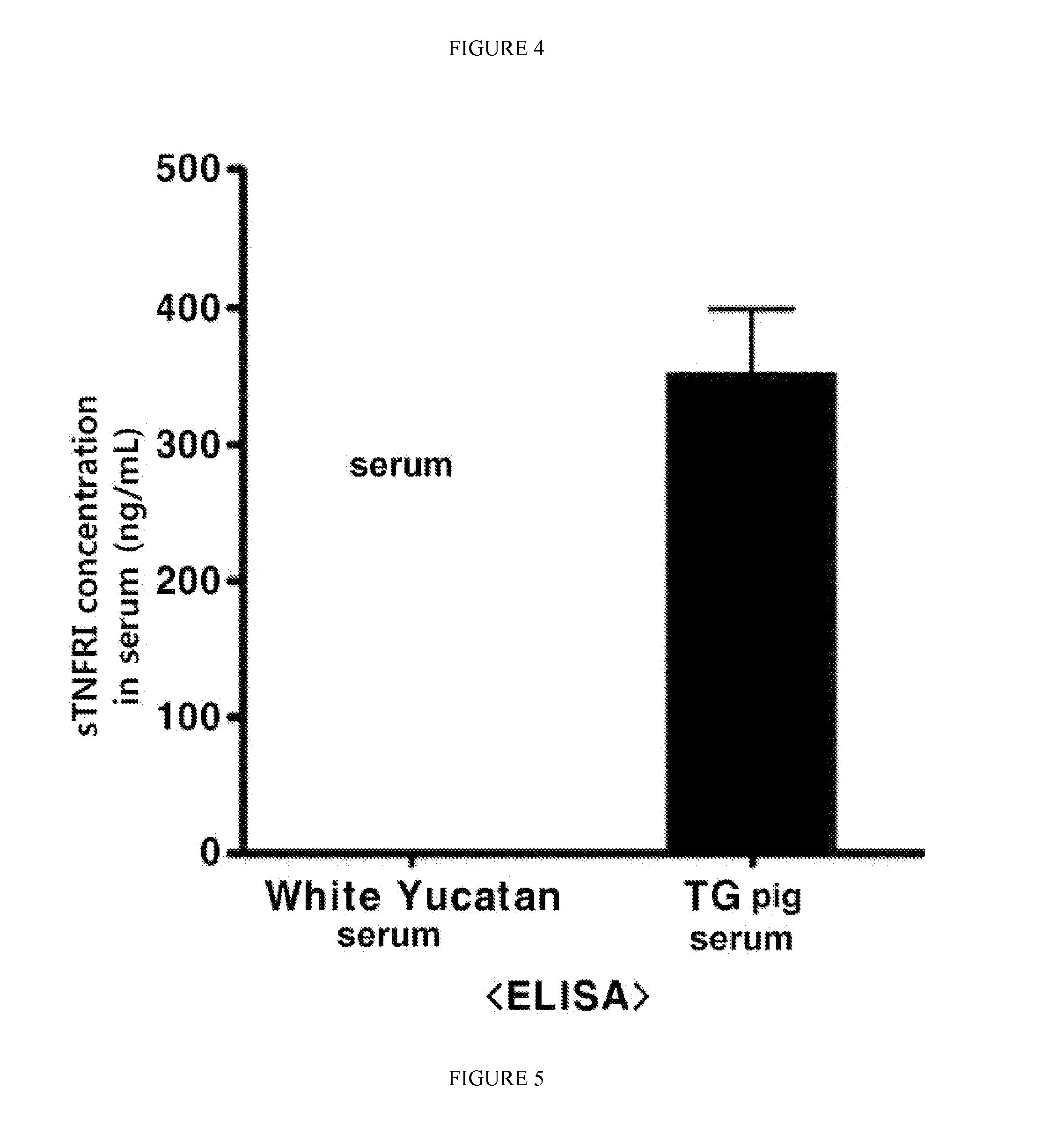Transgenic pig expressing stnfr1-fc genes and the uses thereof
a technology of transgenic pigs and stnfr1-fc genes, which is applied in the field of transgenic pigs, can solve the problems of severe multiphasic immune responses and inflammatory responses, and inability to develop cells into organs, so as to suppress the tnf--mediated inflammatory response, suppress the maturation of dendritic cells, and reduce immunorejection
- Summary
- Abstract
- Description
- Claims
- Application Information
AI Technical Summary
Benefits of technology
Problems solved by technology
Method used
Image
Examples
example 1
Construction of the sTNFR1-Fc Fusion Gene-Expressing Vector
[0077]The sequence of the gene encoding a tumor necrosis factor receptor 1 (TNFR1) was analyzed by using NCBI website (http: / / www.ncbi.nlm.nih.gov / ) and ExPASy website (http: / / expasy.org / ) and based on this sequence, the forward primer (5′-ataagcttat gggcctctccaccgtgc-3′, SEQ ID NO: 1) and the reverse primer (5′-tgtggtgcct gagtcctcagtg-3′, SEQ ID NO: 2) of the extracellular domain of TNFR1 were prepared. Also, through the sequence analysis of a human immunoglobulin G1 gene, the forward primer (5′-acatgcccaccgtgcccagc acc-3′, SEQ ID NO: 3) and reverse primer (5′-atctcgagtcatttacccggagacaggg -3′, SEQ ID NO: 4) of Fc region were prepared. Using the prepared primers, a soluble TNFR1 and immunoglobulin G1-Fc (IgG1-Fc) fusion gene were obtained by PCR (sTNFR1-Fc, SEQ ID NO: 5). In order to express the obtained gene, an expression vector pcDNA6 (Invitrogen, CA, USA), which comprises a blasticidine resistance gene and whose expressi...
example 2
Isolation and Culturing of Nuclear Donor Cell
[0079]Fibroblasts obtained from fetal pigs having a blood type O were used as a nuclear donor cell. Firstly, fetal pigs were obtained from sows between day 25 to 35 of gestation by cesarean. The skin on the back of the fetal pig was removed using a scalpel blade, and washed with Dulbecco's Phosphate Buffered Saline (DPBS) three times, and then minced. The minced skin tissues were treated with Dulbecco's modified Eagle's medium (DMEM; Gibco Life Technologies, MD, USA) containing 0.25% trypsin and 1mM EDTA at 37° C. for 1 hour. The trypsin-treated cells were washed with Ca2+- and Mg2+-free DPBS once, and centrifuged at 300×g for 2 minutes, and then inoculated in a 60 mm plastic culture dish (Becton Dickinson, NJ, USA). Subsequently, the cells were cultured in DMEM containing 10% (v / v) FBS, 1 mM glutamine, 25 mM NaHCO3, and 1%(v / v) minimum essential medium (MEM) non-essential amino acid solution (Invitrogen, CA, USA) at 39° C. and in 5% CO2 ...
example 3
Preparation of Somatic Donor Cell Line
[0081]Porcine fibroblasts were seeded in a 35 mm plastic culture dish (Becton Dickinson, NJ, USA) at a density of 3×105 cells / well, and the next morning, 1 ug of the gene expression vector (pcDNA6 / sTNFR1-Fc), which was prepared in Example 1 and linearized by the restriction enzyme ScaI, was diluated with 50 ul of Opti-MEM I Reduced Serum Medium (Invitrogen, CA, USA). Also, Lipofectamine™2000 having a same volume as the gene expression vector was diluted in 50 ul of Opti-MEM I medium, and incubated at a room temperature for 5 minutes. After incubation, the diluted sTNFR1-Fc expression vector and the diluted Lipofectamine™2000 were mixed together and incubated at a room temperature for 20 minutes. After incubation, the mixture was added to the cells in a 35 mm culture dish, and cultured at 37° C. in CO2 incubator. After 4 hours, the media was replaced with DMEM (Invitrogen, CA, USA) supplemented with 10% FBS and penicillin / streptomycin, and then c...
PUM
| Property | Measurement | Unit |
|---|---|---|
| volume | aaaaa | aaaaa |
| thickness | aaaaa | aaaaa |
| physiological structure | aaaaa | aaaaa |
Abstract
Description
Claims
Application Information
 Login to View More
Login to View More - R&D
- Intellectual Property
- Life Sciences
- Materials
- Tech Scout
- Unparalleled Data Quality
- Higher Quality Content
- 60% Fewer Hallucinations
Browse by: Latest US Patents, China's latest patents, Technical Efficacy Thesaurus, Application Domain, Technology Topic, Popular Technical Reports.
© 2025 PatSnap. All rights reserved.Legal|Privacy policy|Modern Slavery Act Transparency Statement|Sitemap|About US| Contact US: help@patsnap.com



